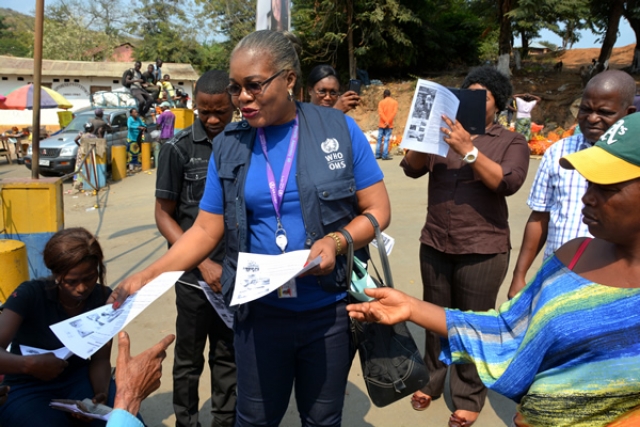Kongo Central Province: social mobilisation and yellow fever risk communication efforts continue in land border checkpoints
 Ango-Ango (Matadi, Kongo Central), 8 July 2016 -- In a bid to intensify health information dissemination and effective communication among the population living on both sides of the border, in response to the yellow fever epidemic hitting both Angola and the Democratic Republic of Congo (DRC), a WHO risk communication and social mobilization team, supported by the Kongo Central Provincial Health Division (DPS), visited Ango-Ango, a border checkpoint between DRC and Angola.
Ango-Ango (Matadi, Kongo Central), 8 July 2016 -- In a bid to intensify health information dissemination and effective communication among the population living on both sides of the border, in response to the yellow fever epidemic hitting both Angola and the Democratic Republic of Congo (DRC), a WHO risk communication and social mobilization team, supported by the Kongo Central Provincial Health Division (DPS), visited Ango-Ango, a border checkpoint between DRC and Angola.
The team first met with officials of the migration services (DGM), the border police, the national border hygiene programme (PNHF), as well as the medical staff for a briefing on disease surveillance at borders and compulsory vaccination for all travellers. “We cannot lower our guard so long as the yellow fever epidemic is ongoing in our two countries", says Marie-Claire Fwelo Mwanza, in charge of health promotion, community participation and risk communication at WHO DRC. She adds that WHO is "collaborating closely, at all levels, with the political, administrative and health authorities of DRC, not only to mitigate high-risk perception of the current epidemic, but also to make communication essential in managing the spread of the yellow fever virus in a health emergency context”.
"The visit to our premises and the discussions on the health risks facing our populations due to yellow fever encourage us to step up our commitment and cooperation towards implementation of joint multisectorial and crossborder activities in response to yellow fever” notes Mr Kapya Nyange, head of migration at the Ango-Ango border checkpoint.
Ango-Ango is the main official gateway located south west of Matadi, the provincial headquarter of Kongo Central, where hundreds of itinerant traders and vendors of various goods cross both sides of the common border every day. “It is essential to deliver correct information on the early signs enabling to recognize yellow fever and its mode of transmission", explains Anastasie Nyati, a PNHF nurse in Ango-Ango. Recently, “we suspected yellow fever in an Angolan girl from Noqui. She had fever and jaundice was easily noticeable in her eyes. She aimed to cross into Kongo Central, but we quickly alerted the Zaïre Province health authorities in Angola, and the patient was admitted in a facility in Mbanza-Congo, in Angola, for appropriate care" she attested.
On the Angolan side, in Noqui, a municipality of the Zaïre Province, and throughout Mbanza-Congo, headquarter of the Zaïre Province, (North Angola), "sensitization on the yellow fever threat is ongoing, including in places of worship, to tell people that the epidemic is not yet over”, emphasizes Samuel Manuel, the provincial health section head at the Noqui border post (Angola). He also took part in a working session with the WHO-DPS team in Ango-Ango on joint response strategies against yellow fever.
_____________________________________
For further information, please contact:
Dr Yokouidé Allarangar, WHO Representative in DRC, allarangaryo [at] who.int (allarangaryo[at]who[dot]int)
Media contact:
Eugene Kabambi, communications officer, kabambie [at] who.int (kabambie[at]who[dot]int)
Marie-Claire FweloMwanza, in charge of health promotion, fwelom [at] who.int (fwelom[at]who[dot]int)
_____________________________________
Photograph 1: Marie-Claire Fwelo Mwanza, in charge of health promotion (WHO DRC), distributing printouts containing key messages on yellow fever to itinerant vendors at the Ango-Ango border checkpoint, in presence of DGM, DPS and PNHF officials in Matadi
WHO/ Eugene Kabambi
Photograph 2: travellers about to cross the border come back to ask questions about yellow fever; they also claim the printouts containing key messages on the yellow fever virus; discussions at the Ango-Ango border checkpoint (DRC) ; in the background, the Noqui checkpoint on the Angolan side of the border
WHO/ Eugene Kabambi





